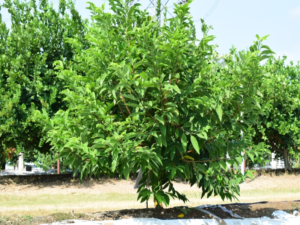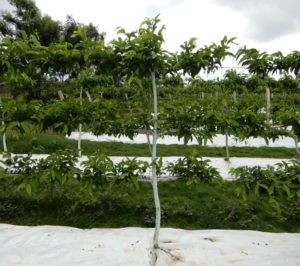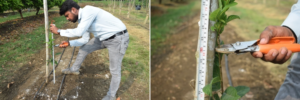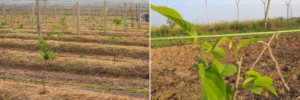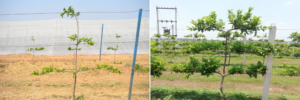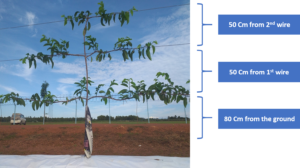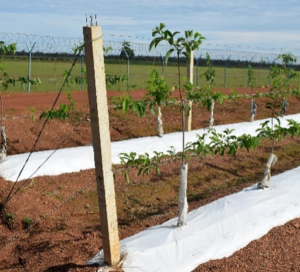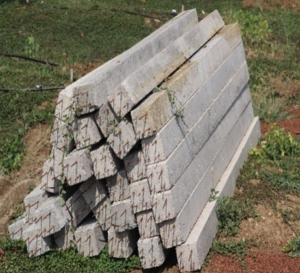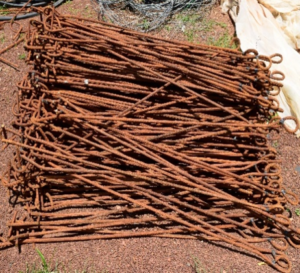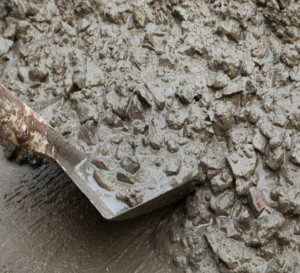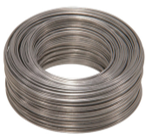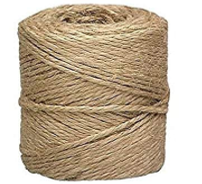What is training?
Training is an art of maintaining or giving proper desired shape/structure to the plant during initial growth and development.
Type of training – Round & Espalier System
Round–When the tree is trained onto the round or umbrella like structure then it is termed as the round canopy system.
Espalier/ SLT (Single Leader Terellis) – It is the art of training the plant in two dimensions like a wall
Why training is required in VNR Madhur plant?
Training of VNR Madhur plant is done to:
Allow sunlight to pass through every branch and centre of the plant. This ensures minimum chances of development of insects and other pests. Insects and pests proliferate in dark.
Get maximum yield from the plant in confined space.
Make all branches accessible so that operations like harvesting, bagging can be done easily.
Materials required for training of VNR Madhur plant
Secateurs (cutter)
Jute thread/ Sutli
Measuring tape
How to do training of VNR Madhur plant?
- Top-cutting: Plants when grows up to the height of 2 ft from ground, their top is cut. This checks the vertical growth of the plant and promotes horizontal branches. This practice is generally done 40-50 days after plantation.
- New shoots below the cut start emerging; these are allowed to grow if they are coming in between 1.5 ft to 2 ft from ground level. Sprouts coming below this level are removed.
3. To maintain proper balance of VNR Madhur plant, the new branch which emerges after cutting should be balanced on all directions and one amongst it should be tied up with stake for vertical growth. - A) 1 branch is tied with bamboo stake for vertical growth of plant
- When horizontal branches achieve or reach length of 2 ft from their point of emergence, they are cut. These branches are called as secondary branches/shoots.
- Branches grown below 1.5 ft from ground level are removed. These branches, if allowed to be grown further, will touch the ground and help insects/pests to climb the plant. Further, these branches interfere in other intercultural operations at the base of the plant.
6. Fifth (5th) secondary branch, which was tied with bamboo stake to grow vertical, is subject to a cut–when it achieves/reaches height of 5 ft from ground level. - Tertiary branches (branches coming out from secondary branches) are also cut, when they attain 2 ft length from their point of origin/emergence in secondary branch.
- Tertiary sub-branches coming out of tertiary branches if growing inwardly or interfering with other branches are cut/removed. These braches-if not removed, will not allow sunlight to reach the centre of plant and interfere with growth of plant.
Thumb Rule:
Cut every branch from its origin, when it achieves/reaches 2 feet length in round type of canopy system.
DOs and DONTs:
DOs > Do the cutting of branches as directed by VNPL.
DONTs > Do not do excessive cutting of plant. If excess cutting is done, plant becomes bushy. Bushy plants bear lesser number of fruits.
DOs >Cut branches if length is more than 2 feet OR tie these branches with stake by jute thread (sutli)
DONTs > Do not tie all branches together with stake to protect branches from wind.
Frequently Asked Questions (FAQs):
Q – What if 5 branches are not coming after top cutting?
Answer: Sometimes only 2 or 3 branches emerge after top cutting, in this case farmer can allow these branches to attain 2 ft length and again, do tip cutting. After this cutting when sprouts come in these 2 branches, we can allow these sprouts to grow in desired directions as secondary branches.
Q – Can we tie all branches together with stake to prevent branches from breaking in high/heavy wind blowing areas?
Answer: No, this is a wrong practice. Farmer can reduce the length of the branch by pruning, if they are prone to breakage in high/heavy winds.
Q – What if plant becomes bushy due to excessive cutting?
Answer: The plant when becomes bushy, it is confined to canopy that is less to its expected spread. This reduces the production area of the plant. Moreover, sunlight interception will be less in bushy plants which may result in development of insect/pest colonies.
Training of Plants in Espalier System
Single Leader Terellis system
Introduction:
The word espalier is French, and it comes from the Italian spalliera, meaning “something to rest the shoulder (spalla) against.” during the 17th century, the word initially referred only to the actual trellis or frame on which such a plant was trained to grow, but over time it has come to be used to describe both the practice and the plants themselves.
Earlier simple round canopy management was followed. Though it was comparatively cheaper method but it has some drawbacks like, the fruits in the innermost branches are more prone to fungal attack due to less sunlight availability, cover more space and labour intensive.
Advantages of Espalier system:
- Adopting this system provides the maximum utilization of land.
- It provides easier access for pruning and harvesting.
- Less disease and pest attack due to optimum sunlight.
- The fruits can be harvested in 1st year as the plant is supported by wires so plant does not collapse by the weight of fruits.
- It adds aesthetic value to orchard.
- Espaliers have also been used to create living fences.
Pole to pole dist. in a bed 32 ft.
- 1st wire distance from bed: 80 cms
- Distance between 1st and 2nd wire: 50 cms
- Distance between 2nd and 3rd wire: 50 cms
N.B – The Cost is Tentative Please Confirm Cost from Local Market.

